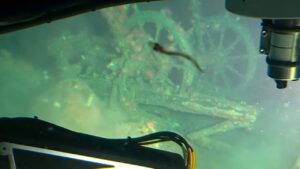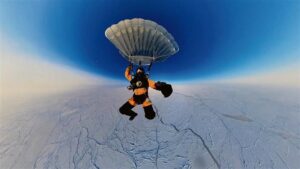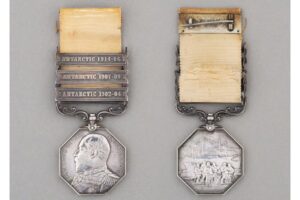The North Pole season, based out of the floating ice station called Barneo, was recently canceled for the third year in a row. Typically set up about 100km from the North Pole, Barneo has hosted marathon runners, North Pole champagne tourists, and Last Degree skiers for 19 years. It’s a complicated, expensive, but one-of-a-kind operation. With this third cancellation, some are asking: Has the Barneo experiment run its course?
To understand Barneo’s potential future, it helps to understand its past. I’ve been there since the beginning. Thirty-one years ago, on May 1, 1990, on International Workers Day — the biggest holiday in what was then the Soviet Union — a U.S. Air Force plane flew over an ice floe called North Pole 31, the predecessor of the Barneo Ice Camp. With great precision, they dropped a care package between our tents. Inside were a few chocolates and a Playboy magazine. For us, some 20 men and one woman, living in the world’s northernmost community, adrift on the Arctic Ocean, it was an overwhelming moment.
We were certainly grateful for delicacies for which we were all longing, but mostly we were happy for the glimpse of hope that this “adversary” plane brought to us. For years, we were busy watching them –- the NATO planes and submarines — and they were watching us. But with the arrival of Gorbachev’s perestroika, hope arose that we could build a community, a family, in the most pristine neighborhood in the world –- the Arctic Ocean, which we all loved and belonged to.

More than three decades have passed since then. The days of North Pole stations, financed mostly by the Soviet Ministry of Defense, are long gone. Ice Camp Barneo, an illegitimate child of the NP Soviet station, with fancy warm tents and actual outhouses, is now owned by a Swedish billionaire. Every spring, it serves polar adventurers, scientists, and tourists from the West. But it is still operated by a small Russian crew, whose love and passion for this place was born back in the romantic 1980s. They use their vacation time to come here and work 24/7 — not for big bucks, but for the chance to revive once more the spirit of arctic camaraderie.
Barneo’s origins
Barneo was started in 2002 by a man whom I knew back in the 1980s. He was one of the most talented arctic ice navigators. He knew sea ice inside out. With the arrival of capitalism in Russia, he discovered another talent –- that of an entrepreneur. His name was Alexander Orlov, and under his leadership, Ice Camp Barneo prospered.
Each season, many things could have gone wrong. and often they actually did, but the resourceful Orlov always found a solution. He knew how to navigate through the ice in the foggy Arctic, but he also knew how to navigate the treacherous corridors of post-Soviet bureaucracy, an art mastered by few. He built partnerships, reached unlikely compromises, and made seemingly doomed operations a success.
Then on May 1, 2017, Orlov suddenly died from a heart attack, a few days after another North Pole season. Irina Orlova, his wife, took over. She had passion, competence, and dedication, but she soon learned that even in 2018, being a woman in the Arctic was taboo.
Women are bad omens here
There are many unspoken taboos in the Arctic. When I first considered traveling to a Soviet polar ice station at the end of the 1980s, I was told not to come. Why? I had spent years as Pravda’s arctic reporter, traveled for months across the frozen tundra with indigenous caribou herders, knew the land and how to live in it.
Out there, all of us, men and women, were equal members of a community. But the drifting ice camp, conceived and built by white men eager to show their superiority and hoist their country’s flag, was a different realm.

Commercialism comes to the Soviet Arctic: Galya Morrell models in an ad for a motorcycle.
There, I was a “bad omen”. Polar explorers were convinced that if a woman landed on the ice, the runway would break. If not that exactly, then something else would go wrong and good luck would vanish. To live with these men on the ice, I had to denounce my womanhood in front of my comrades, who lived according to their beliefs and traditions. I can’t blame them for that. In my country, we had a tradition of renouncing our past, our ancestors, our beliefs, in order not to get sent to the gulag. Such were the times. Here, I just had to give up my privacy and agree to be treated exactly as a man.
Navigating Russian bureaucracy
Attitudes had changed by 2017, but even then, a woman leading the drifting Ice Camp was considered an absurdity. Grey-bearded polar explorers and Russian bureaucrats colluded to thwart Irina. They were sure that they would succeed. They were big, strong, and husky, and Irina weighed only 43kg at that time.
Barneo was pronounced dead a few times, but Irina did not give up. She learned to navigate the intricate bureaucratic and cultural minefield and achieved one of the most beautiful seasons in Barneo’s history. We hugged each other and cried when I landed there with a group of children, part of a mission that combined arts and science.
But even then, the notion that women were bad luck in the Arctic did not go away. In 2018, Irina sold Barneo to a Swiss company owned by Swedish billionaire and polar philanthropist Frederick Paulsen.
Under new management
Paulsen is a man whose passion for the North cannot be doubted. Over the last 10 years, I have met him frequently across the Arctic, from northern Russia to northern Greenland. Unlike many, he cared for the indigenous people. He also cared for children. In 2011, when Russian polar explorer Dmitry Shparo and I failed to raise enough funds for another children’s project, Paulsen stepped in at the last moment to save the day. Without making a big deal of it, he traveled from far away to meet the kids, ate at the worker’s mess, and during one breakfast, said something I’ll always remember: “Just be curious, because curiosity is the most powerful engine that drives progress.”
The first season under the new management was ought to have been smooth and easy. But then something happened. You can call it bad luck if you wish. And it had nothing to do with the weather.

An ugly political dispute between Russia and Ukraine, stemming from Russia’s 2014 invasion of Crimea, caused the abrupt cancellation of the 2019 season. Barneo was no longer official Russian territory, but it was still impossible for a Ukrainian AN-74 plane, the only big aircraft suitable for the ice runway, to land at this still quasi-Russian station. A backup plane could not be arranged, and at the last moment, the whole operation was aborted.
Next year, in 2020, Barneo now had its own AN-74 and so was no longer dependent on Russian goodwill. But then the pandemic arrived and scuttled the season overnight. In 2021, Barneo was canceled again for the same reason.
This year, I was supposed to bring a group of New York-based contemporary artists, eager to paint the movement of the ice. They had bought their tickets for the previous season and patiently waited for a year. When this latest cancellation occurred, they were devastated. So were over 350 skiers, divers, runners, scientists, and overnight tourists. The Arctic requires patience, but really, how much patience can you expect from people?
Barneo had functioned like clockwork for 18 seasons, but everything has its time. Is Barneo’s time up?

Morrell works her way back to camp during a storm.
Barneo’s future
I believe that it will survive. Barneo is much more than just a business operation, more than a luxury floating hotel near the North Pole. It is a dream, like the North Pole itself.
In a children’s picture book that I once wrote about the North Pole, I explained how the North Pole does not really exist. If you think about it, it’s pure illusion, a mathematical abstraction, to be exact. There is no way to stay at the North Pole. Once you reach it, you lose it, and then you have to reach it again. The fact that it is unattainable makes it an eternal fatal attraction.
And the same with Barneo. It lives for only one month a year. Then it ceases to be. It melts, or drifts away, disappears, which makes it also a fine dream, a fairy tale to which all of us wish to belong.
Although Barneo will stay, things may change. There may be other routes to Barneo, via Franz Josef Land, Krasnoyarsk, Khatanga, or Sredny. The last route, actually, had been used for years until 2002, when Longyearbyen was chosen as a stopover since it was more suitable for Europeans, Barneo’s main customers at the time.
But for the increasing number of Asian tourists, the Khatanga route is by far the most convenient. A hotel is being built in Khatanga for the needs of these polar travelers. Khatanga does not rival Longyearbyen yet, but things can change quickly in this fast-changing world.

Visual artist Galya Morrell has lived and traveled in the Arctic for over 30 years. Under the stage name ColdArtist, Galya explores the limits of the body and the possibilities of the mind, working in a rare genre of visual synthetic performance on the drifting sea ice. Together with Greenlandic polar explorer and actor, Ole Jorgen Hammeken, Galya has founded many cultural initiatives focused on the circumpolar regions.






